The Space Shuttle Challenger Disaster
The Space Shuttle Challenger disaster is probably the most significant event in the history of spaceflight in terms of its impact on the general public and on the US space program. The death of a crew of seven, which for the first time included civilian astronaut Christa McAuliffe, in a fiery explosion broadcasted in national television for days after the accident left a mark in the public imagination.
Even deeper was the impact on the NASA. Blinded by the success of the early Shuttle flights, the Agency’s management had developed a careless attitude towards warnings coming from the engineering community. NASA had committed the Shuttle to an impossible schedule even before it entered in service in order to ensure funding. Over time, NASA management had grown increasingly impatient with the technical delays that operating such a complex machine required.
All that ended on the bitter cold morning of January 28th 1986, when seven astronauts lost their lives in front of family, friends, and millions of TV viewers. A vehicle that was celebrated for its technical prowess broke up 73 seconds into the flight, burning nearly 2 million liters of fuel in just a few seconds, creating a sinister cloud of gas that still plagues the memory of anyone who saw it.
This section of Space Safety Magazine is dedicated to the Challenger Disaster, its causes, and its consequences.
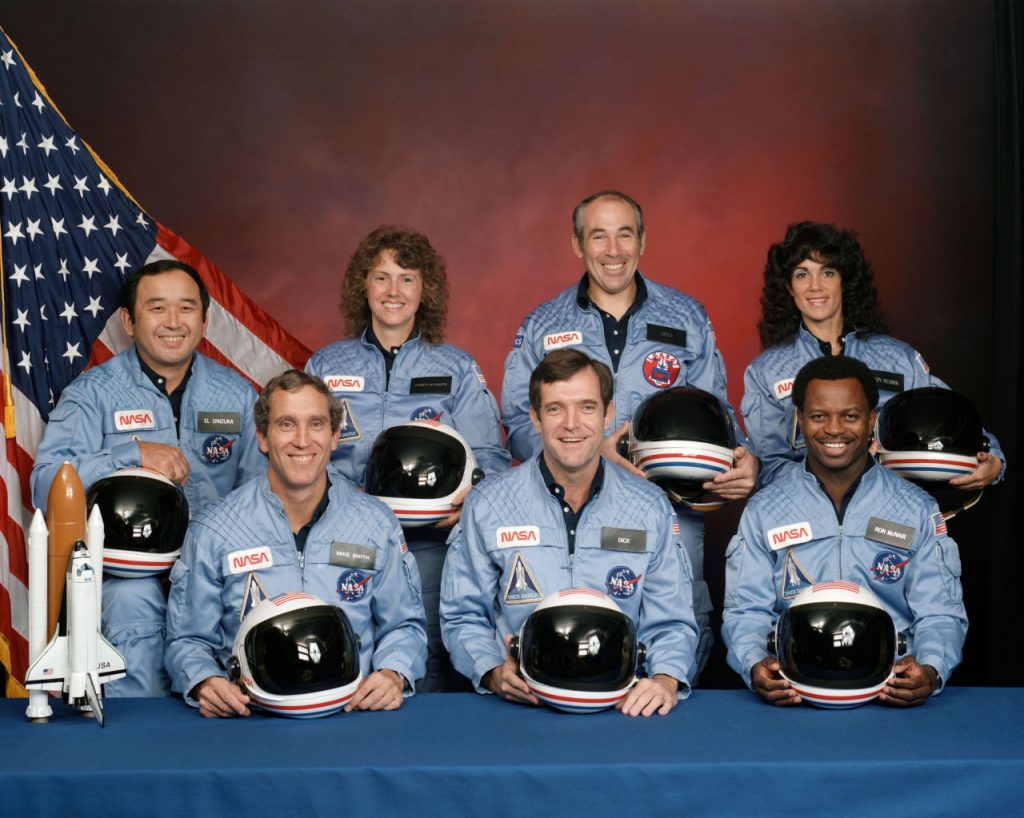
The crew of Space Shuttle mission STS-51-L. In the back row from left to right: Ellison S. Onizuka, Sharon Christa McAuliffe, Greg Jarvis, and Judy Resnik. In the front row from left to right: Michael J. Smith, Dick Scobee, and Ron McNair. Credits: NASA
A Cold Launch Day
Throngs of people stood on Florida’s Cape Canaveral, shouldering the balmy air on the day of one of the greatest losses of NASA’s Space Shuttle Program: January 28, 1986. It was a frigid morning—so cold that ice pooled in sections on the launch pad and icicles hung from the launch tower.
The crowd, composed of friends, family, and supporters of the seven-person crew aboard Challenger, restlessly awaited takeoff. According to the original timeline, the reusable shuttle should have launched six days earlier, on January 22. Administrative delays and poor weather conditions pushed that date back to January 23, then 24, then 25, then 27, and finally, the 28. After a final two-hour delay due to the ice and a failed fire-protection device, NASA cleared the liftoff for 11:38 a.m.
Spectators shielded their mouths with scarves as Challenger rose from Kennedy Space Center’s launching pad 39-B, carrying Gregory Jarvis, Judith Resnik, Dick Scobee, Ronald McNair, Mike J. Smith, Ellison Onizuka, and special guest Sharon Christa McAuliffe—a high school teacher. Liftoff marked the beginning of NASA’s 25th mission—a six-day stint dedicated to research and education—and Challenger’s 10th flight.
NASA mission control studied their data screens as the shuttle raced upwards at a speed of Mach 1.92. The shuttle’s engineers watched the live television broadcast with anticipation, knowing the smallest of miscalculations or malfunctions could shred both machine and man. Meanwhile, onlookers cheered. The shuttle’s launch seemed to foreshadow another victory for NASA, demonstrate the technical prowess of mankind, and inspire another round of future space engineers sleeping in rocket-shaped beds.
But in the midst of the celebrations and meditations, 73 seconds into the launch, pilot Mike J. Smith uttered the words “uh oh,” and fire and smoke engulfed the supersonic shuttle. The crowd’s cheers turned to cries. Pieces of Challenger rained to the ground as others parachuted to the sea.
[cleveryoutube video=”nmAbcDud2L8″ vidstyle=”1″ pic=”https://www.spacesafetymagazine.com/wp-content/uploads/2014/07/Challenger_explosion.jpg” afterpic=”” width=”” quality=”inherit” starttime=”” endtime=”” caption=”The Challenger Disaster Live on CNN. The disturbing view of the spider shaped cloud left an indelible mark on the viewers, comparable to the World Trade Center collapse in September 2011″ showexpander=”off” alignment=”left” newser=””]
The First Civil Astronaut
Among the crew there was Christa McAuliffe, the first civilian astronaut. In 1984, President Ronald Reagan and announced the “Teacher in Space Project,” an initiative was intended to inspire students and to sustain public interest in the over-budgeted shuttle program.
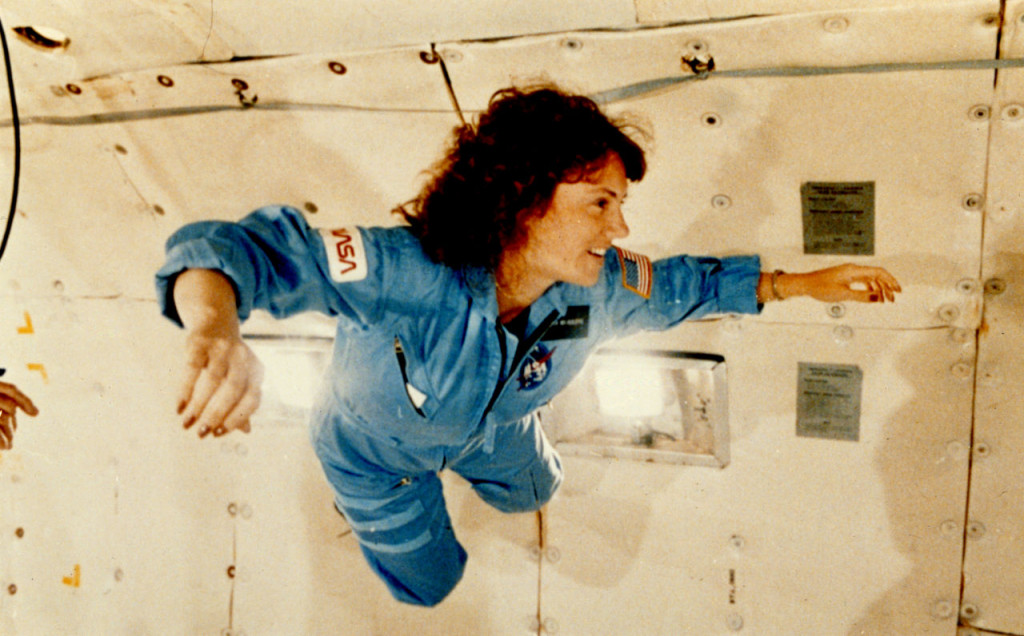
Christa McAulliffe, pictured here while training on the “Vomit Comet.” Her death following the Challenger disaster shocked the American public, who had fallen in love with her manners and composure. – Credits: NASA.
NASA wanted to find an “ordinary person,” a gifted teacher who could communicate with students while in orbit. The idea was that sending a teacher into space would increase public interest in the Space Shuttle program, and also demonstrate the reliability of spaceflight at a time when the agency was under continuous pressure to find financial support.
McAulliffe was selected out of an initial pool of 110,000 applicants. After the selections she became a celebrity, appearing as a guest in many television show. Her manners conquered the American public. “She had an infectious enthusiasm,” said NASA official Alan Ladwig. But what set her apart was also her preparedness. According to NASA psychiatrist Terrence McGuire, she was “the most broad-based, best-balanced person of the 10 [finalists].”
[cleveryoutube video=”2Q-2ra1pXys” vidstyle=”1″ pic=”” afterpic=”” width=”” quality=”inherit” starttime=”” endtime=”” caption=”A rare 1986 documentary, narrated by Burgess Meredith, on the life of Christa Mcauliffe, aired before her tragic death.” showexpander=”off” alignment=”left” newser=””]
A Nation in Shock
Elmer Thomas, a 69-year-old mechanical engineer who had worked for NASA for 18 years, watched the failed flight from a NASA viewing room and complained suddenly of chest pains. He was hospitalized and died a day later—the result: a heart attack.
Much of the nation experienced heartache and paralysis in the hours, days, weeks, and even months following the accident. The hopes of school children to see live science demonstrations from space had been pulverized, and the families of the fallen astronauts struggled to make sense of their sudden and tragic loss. More than 5,000 people held flashlights and candlelights to the cold, immense ocean on Feb. 1, 1986 as a tribute to the perished astronauts. Earlier that day, 4,000 employees of Kennedy Space Center and their families attended a half-hour memorial service.
On the evening of the tragic incident, President Ronald Reagan delivered an address from the Oval Office (which, if it all had gone correctly, would have been the State of the Union lauding NASA’s first-of-its-kind Teacher in Space program). “We’ve never lost an astronaut in flight—we’ve never had a tragedy like this,” he said, adding that his faith in the U.S. space program was unshaken. “We’ll continue our quest in space. There will be more shuttle flights and more shuttle crews and, yes, more volunteers, more civilians, more teachers in space. Nothing ends here; our hopes and our journeys continue.”
During that night, NASA Deputy Administrator William Graham—filling in for Administrator James Beggs who was on leave at the time—conversed extensively via phone calls with the White House. By the next morning, the decision had been made to appoint an external review commission in addition to a NASA internal investigation. This was a notable rift from the Apollo 1 fire investigation of 1967, which was spearheaded by NASA to insulate itself from political or organizational slander. The decision indicated that this time around, NASA would not have such protection. Critics were quick to blame Graham’s inexperience in the agency for his decision to defer the matter to the White House, rather than contain the investigation as best as possible inside NASA.
Reagan publicly announced on February 3 that a 13-person committee chaired by former Secretary of State William P. Rogers would lead the investigation. The committee, now called the Rogers Commission, was given 120 days to determine the probable cause of the accident and recommend corrective action.
[cleveryoutube video=”Qa7icmqgsow” vidstyle=”1″ pic=”” afterpic=”” width=”” quality=”inherit” starttime=”” endtime=”” caption=”Ronald Reagan’s Challenger Disaster speech.” showexpander=”off” alignment=”left” newser=”” margin=”true”]
The Debris Recovery
Immediately after the tragedy, NASA deployed three booster recovery ships primarily intended to locate any floating expended boosters. The U.S. Navy Supervisor of Salvage and commander-in-chief of the U.S. Atlantic Fleet were promptly appointed by DDMS (the Department of Defense Manager for Space Transportation System Contingency Support Operations) to execute the massive search for debris.
The U.S. Navy deployed, among other supporting units, 16 surface ships, two manned submersibles, four ROVs, and one submarine to search for Challenger’s wreckage in the Atlantic Ocean. Divers conducted 3,077 dives with 1,549 hours at the ocean’s bottom from February 8, 1986 to August 29, 1986, according to the US Navy Naval Sea Systems Command Report on the Salvage of the Space Shuttle Challenger Wreckage. It was the largest search operation by geographic area and weight and number of individual pieces salvaged ever conducted by the Navy. The U.S. Coast Guard, the Naval Eastern Oceanographic Center, and a number of contractors assisted the Navy in the search.
NASA had outlined eight pieces of wreckage determined to be priorities for the underwater operations: (1) the right SRB (2) orbiter crew compartment (3) payload (4) tracking and data relay satellite system (5) internal upper stage (6) left SRB (7) specified orbiter components (8) external tank.
By the end of the seven-month operation, approximately 426 sq. nautical miles of ocean seafloor had been mapped by side scan sonar and 711 contacts had been investigated. Fifty percent of the solid rocket boosters, less than 50 percent of the orbiter and external tank, and varying amounts of payload had been recovered. The total cost of the Navy search mission was $13.1 million— the street-value of a duffle bag of cocaine retrieved by Navy sailors during the operation.
[cleveryoutube video=”ST5ks0B2Gwc” vidstyle=”1″ pic=”” afterpic=”” width=”” quality=”inherit” starttime=”” endtime=”” caption=”Rare footage of Challenger debris recovery.” showexpander=”off” alignment=”left” newser=”” margin=”true”]
The Challenger Accident Investigation Board, and the Role of Richard Feynman
By the time Reagan appointed the commission, rumors were already circulating that a faulty solid rocket booster could have been to blame, based on evidence recovered by NASA investigators that showed a rupture in a field joint of the SRB. Within a few days of the presidential commission investigation, those rumors began to transform into probable cause.
Of the 13 members of the commission—William P. Rogers, Neil A. Armstrong, David C. Acheson, Eugene E. Covert, Richard P. Feynman, Robert B. Hotz, Donald J. Kutyna, Sally K. Ride, Robert W. Rummel, Joseph F. Sutter, Arthur B. C. Walker, Jr., Albert D. WHeelon, Charles E. Yeager, and Alton G. Keel, Jr.—four key players emerged: Rogers, Ride, Kutyna, and Feynman.
Rogers, former secretary of state, was tasked with quickly finding the technical cause of the accident, fixing it, absolving NASA of any responsibility, and returning to business as usual. That didn’t happen as planned. The more the commission’s members—particularly Feynman—delved into potential causes of the accident, the more dirt they found on NASA itself. Drama ensued between Rogers and Feynman when Rogers wanted to leave out of the final report a portion of Feyman’s findings that were sensitive to NASA. Feynman threatened to withhold is signature, so Rogers gave in, and Feynman’s work became the appendix to the official report.
Sally Ride, the first female U.S. astronaut, often remembered as shy but passionate, headed the subcommittee on operations. Ride anonymously leaked a NASA document to former Air Force General Kutyna that indicated NASA was aware that cold temperatures could damage a critical component on the solid rocket booster: the rubber O-rings used to seal gases. Although she had not exposed her knowledge publicly, Ride famously gave Morton Thiokol engineer Roger Boisjoly a hug of support after he exposed similar information to the commission during a hearing in February. She was visibly relieved to hear the truth from a primary source.
Kutyna, then-director of the Air Force’s Space Systems and Command Control and Communications, gained media coverage mainly through the friendship he forged with Feynman. He realized Feynman was the only member of the commission who enjoyed complete freedom from political pressure and used this relationship to transfer insider knowledge. He also helped Feynman demonstrate to a national TV-viewing audience how cold impacts the properties of an O-ring by holding him back until he was in full-view of the live cameras.
Feynman, a famous physicist and Nobel Prize laureate with a distinct distaste for corruption and red tape, was the subject of the 2013 movie “The Challenger Disaster.” Although he had little demonstrated knowledge of, or interest in, space, his motivation to uncover the truth about Challenger was palpable. Ignoring requests to remain in close proximity to the team in Washington, Feynman boarded a plane and visited unannounced the facilities of Morton Thiokol, the firm responsible for manufacturing the shuttle’s booster rockets. He interviewed Thiokol employees wherever he could—the lunchroom, the hallway, the manufacturing floor—and quickly realized a great fracture in communication between the engineers, manufacturers, and managers both at Morton Thiokol and NASA. As the investigation continued, he discovered a disturbing lack of technical understanding in some of NASA’s highest-ranking managers. The dots became increasingly easier to connect: recklessness and oversight were directly linked to the tragic accident, and Feynman would later demonstrate, on national television, just how much.
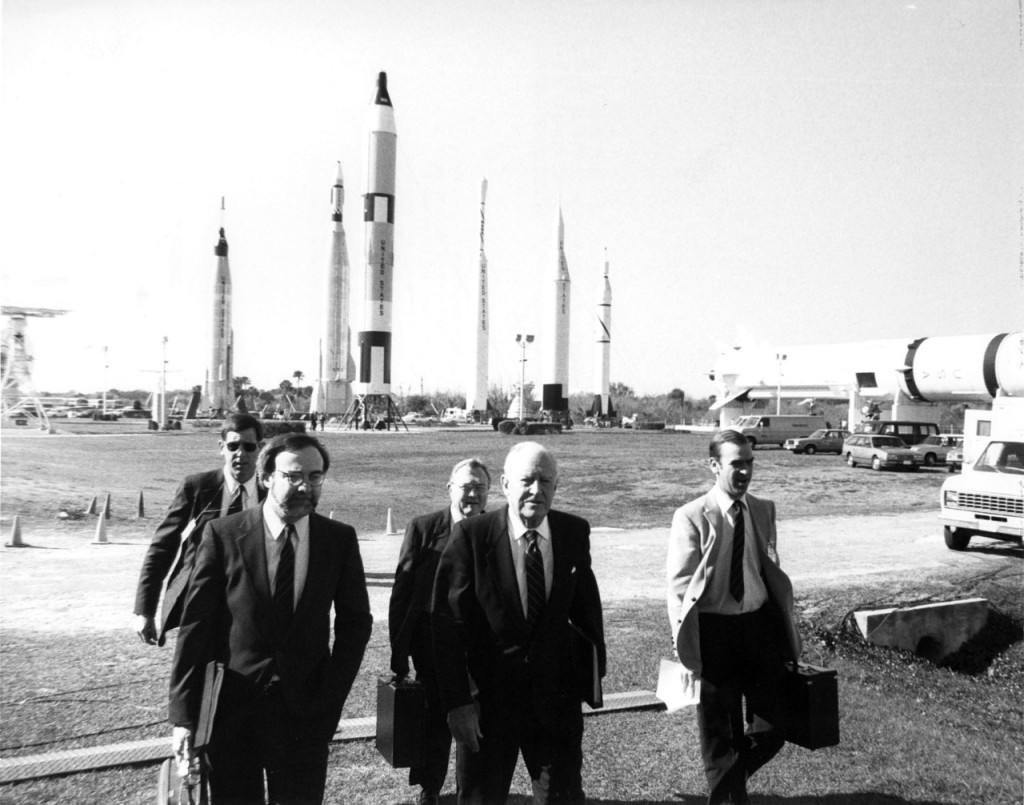
Here, Alton Keel (left), the representative to the Commission from the Executive Office of the President, and chairman William Rogers (center) arrive at the Galaxie Theatre at KSC’s Visitor’s Information Center for a one day briefing and tour of the NASA facility. – Credits: NASA.
The Fate of the Crew
Six weeks into the investigation, rescue crews had located fragments of a SRB, parts of the ship’s wings and fuselage, and the shuttle’s three powerhouse main engines. One of the major discoveries—whose importance at the time was unknown—came on March 1 when divers found contact #131, the section of the right SRB joint containing a portion of a joint burn-through area. The burn hole later proved paramount in determining the cause of the accident.
A few days later, search crews located the 71 cubic meters crew compartment 30 meters under the ocean with the astronauts’ remains on board. The discovery was plastered on newspaper headlines everywhere and brought some semblance of peace to the loved ones of the astronauts. NASA, however, citing reverence to the crew’s families, would not comment on the condition of the compartment nor the bodies.
The discovery of the crew compartment in March was a turning point in the investigation of the accident. A sweep of the cabin illuminated disheartening evidence of the fate of the crew: the emergency oxygen packs had been activated, indicating a high probability that the astronauts survived the apparent explosion and only perished after contact with the Atlantic Ocean. In fact, the commission would later determine, there had been no explosion at all; the shuttle broke up because of aerodynamic loads following a conflagration of gases liberated by the shuttle’s external tank.
On July 28, 1986, Rear Admiral Richard H. Truly, NASA’s Associate Administrator for Space Flight, released a report from Joseph P. Kerwin, a biomedical specialist from Houston’s Johnson Space Center commissioned to find the cause of death for the seven astronauts. Kerwin explained that each crewmember’s helmet was connected to an emergency pack of oxygen called a personal egress air pack, or PEAP, which must be manually activated. Four PEAPs were recovered, he wrote, and three had been activated.
The report, which concluded that the cause of death was indeterminable, indicated that the mid-air breakup forces were “probably not sufficient to cause death or serious injury” but that the crew “possibly, but not certainly, lost consciousness.” It also revealed that the estimated time of free-fall for the seven astronauts before their impact with the ocean was two minutes and forty-five seconds: a horrifying number to those who invested hope in a quick and painless death for the crew. And maybe it was: the compartment slammed into the ocean at a skull-cracking 207 miles per hour, an impact that would kill any human instantly. Speculators to this day go back and forth about whether the crew was conscious during the free-fall, but no conclusive evidence has ever been found.
[cleveryoutube video=”uqcd_3daPQ8″ vidstyle=”1″ pic=”” afterpic=”” width=”” quality=”inherit” starttime=”2:20″ endtime=”” caption=”Astronaut and medical doctor Story Musgrave talks about the fate of the crew.” showexpander=”off” alignment=”left” newser=”” margin=”true”]
Roger Boisjoly and the Recurring Issues with the O-Rings
In time, the investigation revealed another disturbing detail: a piece of paper suggesting NASA’s decision to launch Challenger was not ill-informed, but irresponsible.
On the day of the launch, when Challenger passed through Max Q—the period where aerodynamic forces on the shuttle are at their maximum—former Morton Thiokol engineer Roger Boisjoly exhaled a sigh of relief. The night before, he and others from Utah-based Thiokol held a conference call with NASA managers from Kennedy Space Center and Marshall Space Center. During the call, Boisjoly warned NASA to cancel the launch due to the cold weather and the possibility of rubber O-rings losing their ability to seal the joints of the solid rocket boosters.
NASA, already resentful of the numerous delays, staunchly opposed the idea to wait. NASA’s George Hardy told Morton Thiokol, “I am appalled. I am appalled by your recommendation” while another NASA manager, Lawrence Mulloy, said “My God, Thiokol. When do you want me to launch—next April?”
Thiokol’s VP of Engineering R.K. Lund felt torn, hesitant to override Boisjoly’s and the other engineers’ advice. In turn, Jerald E. Mason, VP of Operations at Thiokol’s Wasatch plant, famously suggested Lund put on his “management” rather than “engineering hat.” Could Thiokol prove, without a doubt, that the forecasted cold temperature posed a high enough risk to the shuttle that NASA should postpone liftoff–again? No, said Mason. Lund followed suit.
The breakup of the shuttle the next day infuriated and deeply depressed Boisjoly, who accordingly felt an enormous loss and guilt for failing to stop the launch—on multiple occasions. The counsel he gave to NASA the night before the launch, after all, was not his first. Six months earlier, Boisjoly had warned in a memo to Lund that the O-rings’ well-known erosion problems should be fixed ASAP to prevent “a catastrophe of the highest order—loss of human life.” The issue had already been brought to the attention of Thiokol management prior to the memo, and a handful of engineers had formed an unofficial team with the intention to investigate further, but, Boisjoly wrote, the team was “essentially nonexistent” and needed direction from management. The memo was intended to be a final alarm bell and call-to-action, but bureaucracy muddled the group’s progress, and the O-rings continued to experience problems.
For years prior, engineers at both Thiokol and NASA’s Marshall Space Flight Center had experienced issues with the erosion and sealing of the rings, so much so that in July 1985 Marshall official Lawrence Mulloy imposed a launch constraint until the problem was fixed or safe. But those constraints were regularly waived and flights, as evidenced by Challenger, continued.
A few months prior, after the third flight of Discovery on a cold January day in 1985, engineers had found that the two primary O-rings had experienced erosion, and that the primary rings in two field and joints and both nozzle joints had soot blow-by. During the investigation of Challenger, then, the Discovery flight—and its implications—became eerily relevant.
Boisjoly was called to testify at one of the commission’s hearings in February and informed them of Thiokol’s attempt to stop the launch. Against the wishes of management, he also presented the panel with the memo about the O-rings he had written six months before. His contribution elevated the investigation to an entirely new level as commission members began to uncover the contextual factors at play. At a hearing in Washington a week later, Rogers announced that NASA’s “decision-making process may have been flawed”—low-hanging fruit for those eager to criticize NASA.
Boisjoly’s whistleblowing did not go unpunished; he was absolved of his Thiokol responsibilities and was shunned and threatened by coworkers. He became sick and depressed and was diagnosed with posttraumatic stress disorder. Although an outcast in the eyes of hundreds in Willard, Utah, he was hailed a hero in 1988 by the American Association for the Advancement of Science, which awarded him its annual Prize for Scientific Freedom and Responsibility. By the time of his death in 2012 at age 73, he had become a sought-after expert in forensic engineering and corporate ethics.
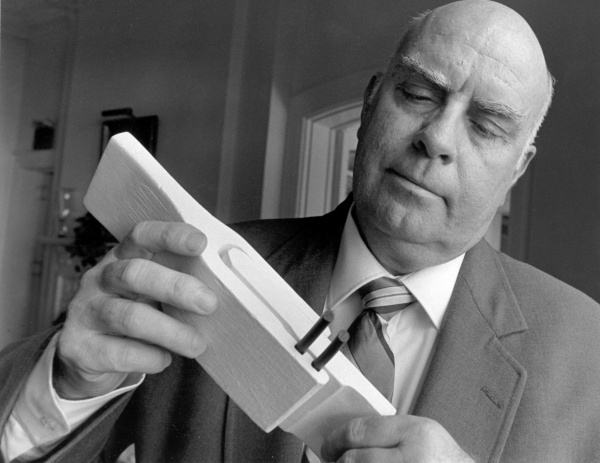
Boisjoly examines a model of the O-Ring at a meeting of senior executives and academic representatives in Rye, New York, Sept. 1991 (Credits: AP Photo).
Richard C. Cook and Budgetary Implications on Shuttle Safety
Another key figure called to testify was Richard C. Cook, a resource analyst at NASA’s Comptroller’s Office in the 80s. Shortly after assuming his position, he was tasked with investigating the budgetary implications of solid rocket boosters based on reported problems with SRB O-rings. After speaking with engineers Paul Herr and Paul Wetzel at the Office of Space Flight, Cook sent a memo to Michael B. Mann, Chief of the STS Resources Analysis Branch, warning him of the significance of the issue and that the budgetary implications “could be immense.” He stated there was little question “that flight safety has been and is still being compromised by potential failure of the seals, and it is acknowledged that failure during launch would certainly be catastrophic…”
Mann discussed the memo with his supervisors, but after speaking directly with the engineers, Mann felt Cook had “overstated the concerns.” In his testimony to the Rogers Commission in February, he said “I got the feeling. . .that there were quite a few actions being taken within the program office to resolve the issue, that there were extensive reviews going on, as there are in almost any technical type of review. So I was satisfied that it was in the proper technical channel, that it was being handled properly, that it was being handled rigorously and thoroughly…”
Cook provided a copy of his memo to The New York Times, and the newspaper reported it in an article entitled, “Nasa Had Warning Of A Disaster Risk Posed By Booster.” The public was becoming increasingly privy to the scandal, and Cook’s open door policy about insider information helped earned him the Cavallo Foundation Award for Moral Courage in Business and Government in 1990. Three decades after the incident, Cook published a scathing account of the whole ordeal entitled Challenger Revealed: An Insider’s Account of How the Reagan Administration Caused the Greatest Tragedy of the Space Age.
The Technical Cause of the Challenger Disaster
Months of investigation revealed the technical cause of the accident and all of its subtleties.
The official Rogers Commission report reads, “The consensus of the Commission and participating investigative agencies is that the loss of the Space Shuttle Challenger was caused by a failure in the joint between the two lower segments of the right Solid Rocket Motor. The specific failure was the destruction of the seals that are intended to prevent hot gases from leaking through the joint during the propellant burn of the rocket motor. The evidence assembled by the Commission indicates that no other element of the Space Shuttle system contributed to this failure.”
The commission members concluded that the “destruction of the seals” was correlated with two things: poor design, which did not allow for redundancy if the primary O-ring failed, and the cold temperatures experienced at launch.
The ambient temperature at the time of Challenger’s launch was 2.2 degrees Celsius. In comparison, reported the commission, a compressed O-ring at 24 degrees Celsius is five times more responsive in returning to its uncompressed shape than a cold ring at -1.1 degrees.
Because of the cold, the two O-rings used in the lower most field joint of the right solid rocket booster had become stiff and lost their ability to completely seal the joint. During takeoff, hot propulsion gases burned through the primary O-ring and began to escape, as evidenced by puffs of smoke captured on video footage seconds after liftoff. Soon, aluminium oxides from the burned solid propellant began to pile up in the secondary O-ring, creating a temporary seal that evaded disaster on the launch pad. But between 32 and 62 seconds after liftoff, Challenger crossed a strong and unexpected jet stream that shook it off course, shaking loose the aluminium slag that had collected. Immediately a flame appeared on the right solid rocket booster in the direction of the external tank, the largest and heaviest component of the space shuttle that contains a liquid oxygen tank, electrical components, and a liquid hydrogen tank.
The blowtorch effect melted the metal on the external tank until the liquid hydrogen inside the tank began to leak out and the attachment between the booster & the external tank broke free. That’s when the entire bottom section of the tank gave way, thrusting the hydrogen tank upward into the oxygen-filled container, instantaneously combusting two million liters of fuel.
The Challenger orbiter was torn apart by divergent aerodynamic forces and the crew compartment began its free-fall descent toward the Atlantic.
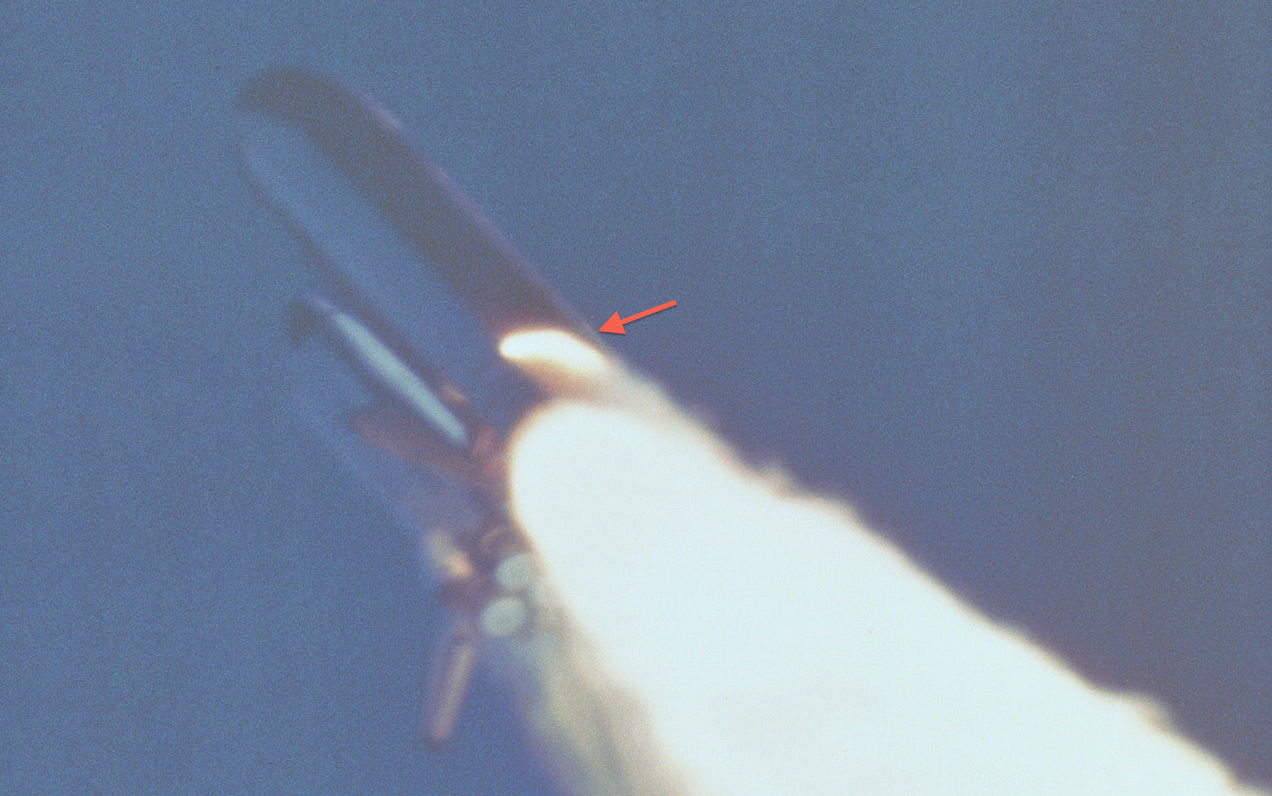
At 58.778 seconds into powered flight, a large flame plume is visible just above the SRB exhaust nozzle indicating a breach in the motor casing. – Credits: NASA.
Richard Feynman’s Demonstration
During one of the commission’s closed meetings in February, Lawrence Mulloy, the project manager at NASA for solid rocket boosters, told the commission members O-rings were required to operate across a wide range of temperatures, but he could not provide detailed test data. The next day, he briefed the commission on the mechanics of the O-ring using jargon, charts, and diagrams. The question still burned: what happens to O-rings exposed to extreme temperature changes? Frustrated, Feynman devised a plan.
During the commission’s next televised hearing on Feb. 11, he submerged a small O-ring into a cup of ice water. A professor of physics at Caltech, he was practiced in the art of simplifying complex theoretical concepts. When he withdrew the O-ring, he applied pressure to it using a c-clamp and then held it up for the NASA officials, and national viewing audience, to see. The O-ring was stiff. “For a few seconds at least and more seconds than that, there is no resilience in this particular material when it is at a temperature of 32 degrees,” he said, “ I believe that has some significance for our problem.”
In less than one minute, Feynman had demonstrated the cause of the Challenger disaster. His overly simple demonstration tore apart all NASA management’s attempts to conceal the truth behind complex language.
[cleveryoutube video=”6Rwcbsn19c0″ vidstyle=”1″ pic=”” afterpic=”” width=”” quality=”inherit” starttime=”” endtime=”” caption=”Feynman demonstrates the O-Ring reaction to cold temperatures.” showexpander=”off” alignment=”left” newser=”” margin=”true”]
The Decision to Launch in the Historical Context
In the days, years, and decades following the tragic incident, NASA endured fierce criticism from those who cited oversight and haphazard management as the reason for NASA’s decision to launch the craft. In fact, NASA was under intense pressure to meet the promise of affordable and routine space travel it made to the American public and to the federal government who funded the Space Shuttle Program.
The program was conceived by NASA under the Nixon Administration in the early 70s as a way to carry humans and payloads to an orbiting space station and became the nation’s only launch system. Although the reality of building and maintaining the complex vehicle overshadowed the ideal of its reliability and versatility, NASA perpetuated the image in order to retain funding that could have gone instead to cheaper, expendable military launchers.
Eager to prove the space program a success, NASA declared the space shuttle an operational vehicle after only four test flights and prepared to fly a citizen in space on the 25th flight—the launch of Challenger. Having already experienced numerous delays to the mission, NASA had tunnel vision to launch the craft, and relied on previous flight successes to nullify the concerns of the engineers at Morton Thiokol. Their overconfidence proved fatal.
[cleveryoutube video=”GcJOUvdogLM” vidstyle=”1″ pic=”” afterpic=”” width=”” quality=”inherit” starttime=”” endtime=”” caption=”Lawrence Mulloy, Marshall’s manager for the SRB project, justifies his decision to launch Challenger.” showexpander=”off” alignment=”left” newser=”” margin=”true”]
The Rogers Commission Report
The official report of the Rogers Commission was submitted to the president on June 9, 1986. The report contains five volumes of data and analysis exploring the technical and organizational reasons for the accident, plus recommendations for an independent oversight committee to implement an improved design of the solid rocket booster joint and seal.
Feynman, having collected a fair share of insights and perspectives on his own, submitted his personal observations for inclusion with the more formal report.
In it, he exposed his reasons to believe NASA’s calculations, and logic, were flawed. Rogers was off-put by Feynman’s harsh portrayal of NASA and thought his findings, though compelling, belonged internally only. In return, Feynman threatened to not sign the final report. Rogers changed his mind, and Feynman’s publication became Appendix F in the report’s second volume.
The conclusion to the appendix suggests NASA suffered from “an almost incredible lack of communication,” and encouraged “ordinary citizens to fly in such a dangerous machine” as the shuttle. The shame-on-you attitude flooded the media and was a disaster for NASA PR. “NASA owes it to the citizens from whom it asks support to be frank, honest, and informative, so that these citizens can make the wisest decisions for the use of their limited resources,” wrote Feynman in his final sentences. “For a successful technology, reality must take precedence over public relations, for nature cannot be fooled.”
Return to Flight
Many people inside and outside of NASA had urged an almost immediate return to flight for the three remaining shuttles after the Challenger accident, but the hiatus lasted nearly three years until September 29, 1988, when Discovery, STS-26, launched from Kennedy Space Center. An all-veteran crew successfully deployed a tracking and data relay satellite and executed a laundry list of scientific and technological experiments. The shuttle landed in California four days later, on October 3. NASA, and the nation, was relieved.
The mission ushered in a new era of spaceflight fueled by redesigned solid rocket boosters, pressurized suits, in-flight crew escape devices, and the establishment of several oversight committees.
The redesign effort at Morton Thiokol was led by Allan McDonald, a senior engineer who staunchly opposed the Challenger launch and was accordingly removed from, and then reassigned to, work involving the solid rocket booster. Engineers at Marshall Flight Center were also actively involved in redesign. In the end, after a rigorous and costly test program of joints, motors, and full assemblies that listed from 1986 to 1988, the booster was announced as safe for use. The redesign added a third O-ring, eliminated the use of putty between the O-rings, added a capture device to prevent or reduce the opening of the joint during ignition, revamped the material of the O-rings, added heating strips around the joints, and reduced the size of the gap openings that the O-rings sealed.
The Challenger Disaster in Pop Culture
The Challenger accident is the subject of the movies “Challenger” (1990) and “The Challenger Disaster” (2013).
“The Challenger Disaster” aired on the Discovery and Science channels and brought in nearly 5 million viewers. Retired NASA manager Jud Lovingood filed a $14 million defamation suit against Discovery communications in February 2014 for Sean Michael’s portrayal of him. The lawsuit claims Lovingood’s character is shown testifying falsely that the odds of a shuttle failure were much higher than other NASA engineers calculated.
[cleveryoutube video=”Pt_EvmjEPP8″ vidstyle=”1″ pic=”” afterpic=”” width=”” quality=”inherit” starttime=”” endtime=”” caption=”The Challenger Disater (2013) Movie Trailer” showexpander=”off” alignment=”left” newser=”” margin=”true”]
Aside from the movies, many of the investigation’s key players have analyzed the disaster in books including Allan McDonald’s Truth, Lies, and O-Rings: Inside the Space Shuttle Challenger Disaster, Feynman’s What Do You Care What Other People Think?, and Richard C. Cook’s Challenger Revealed: An Insider’s Account of How the Reagan Administration Caused the Greatest Tragedy of the Space Age.
– By Michelle La Vone

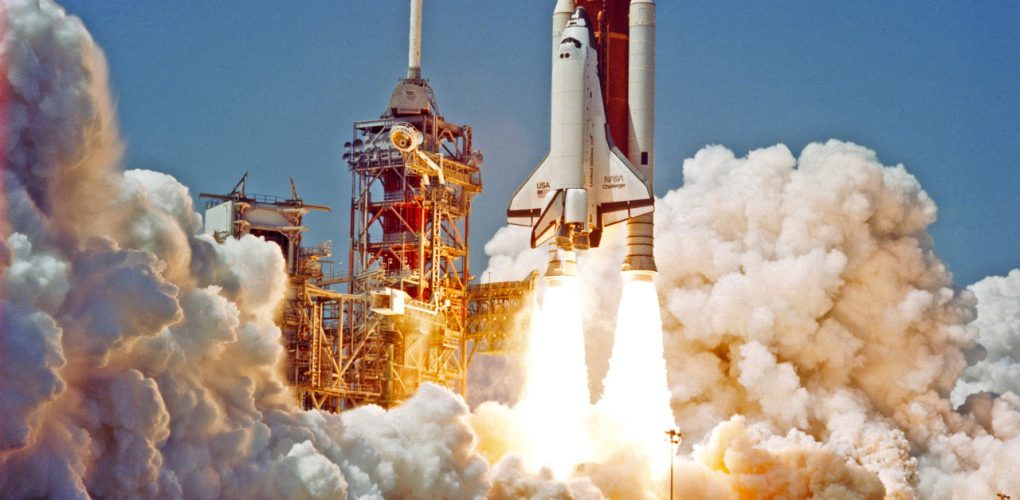
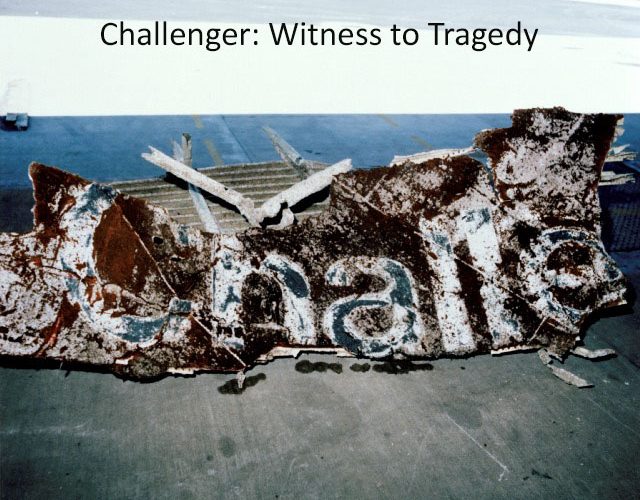
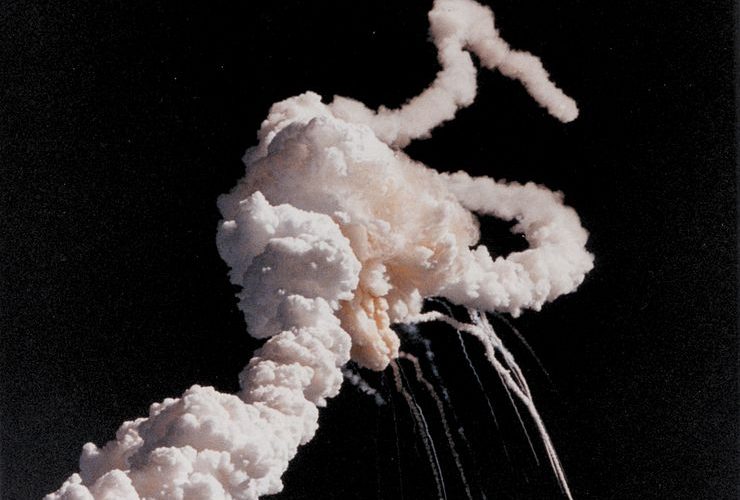
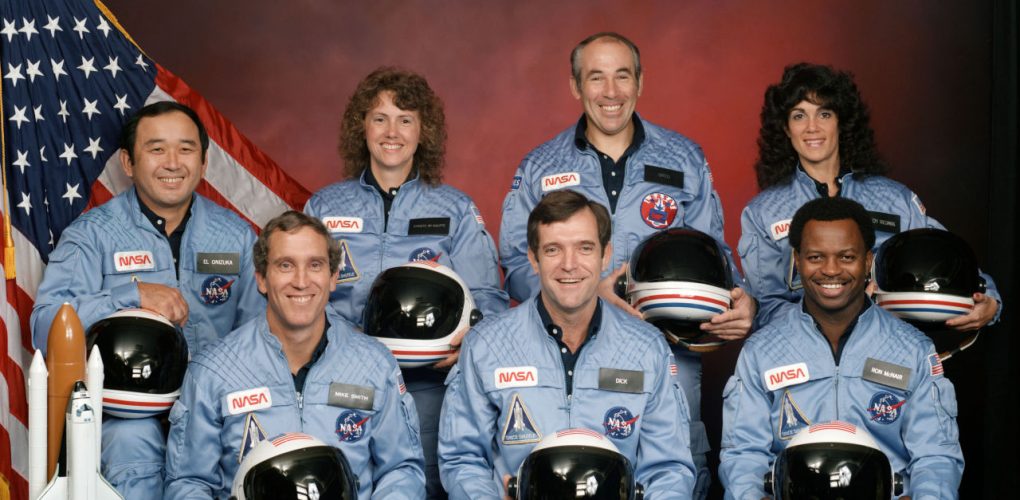
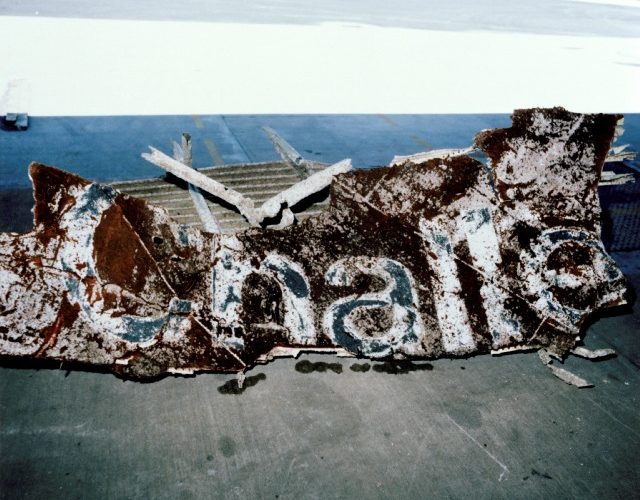
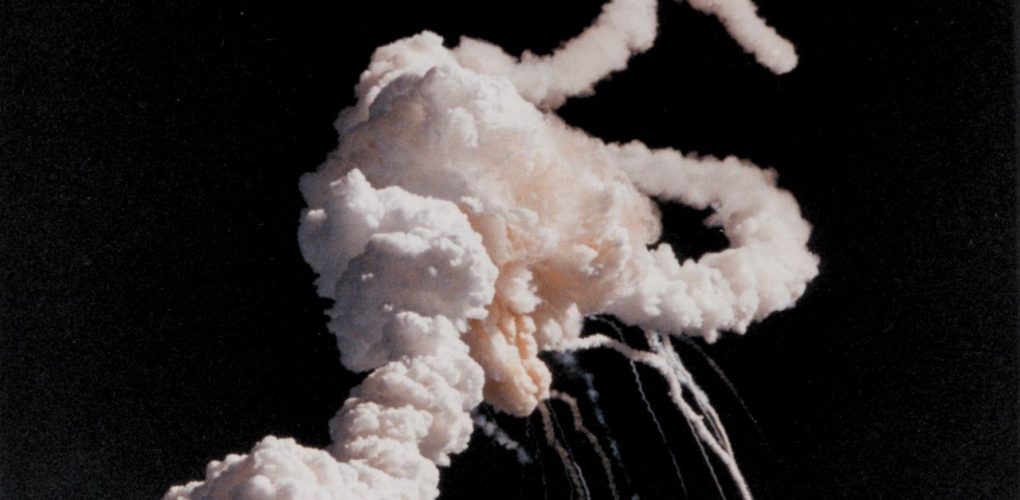
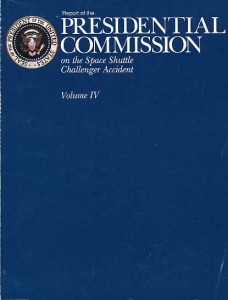
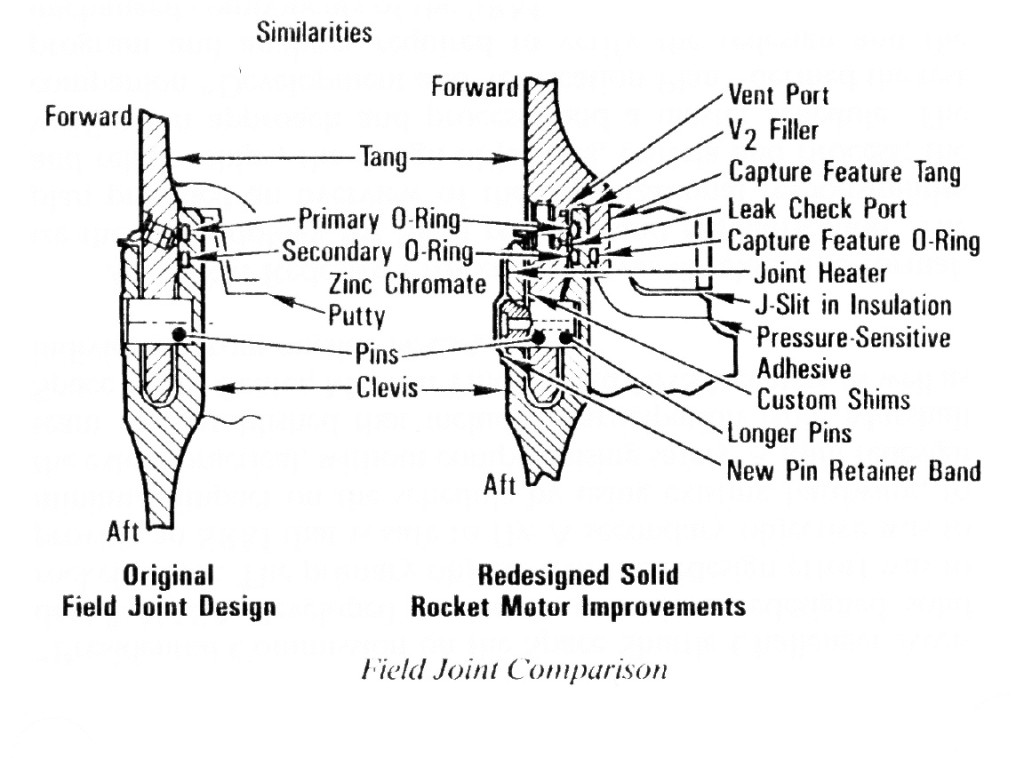




























![A trajectory analysis that used a computational fluid dynamics approach to determine the likely position and velocity histories of the foam (Credits: NASA Ref [1] p61).](https://www.spacesafetymagazine.com/wp-content/uploads/2014/05/fluid-dynamics-trajectory-analysis-50x50.jpg)


